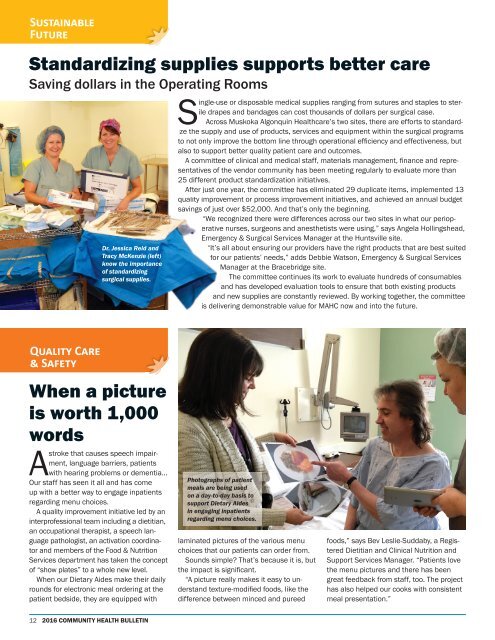MAHC-Community-Health-Bulletin-Final
Create successful ePaper yourself
Turn your PDF publications into a flip-book with our unique Google optimized e-Paper software.
Susne<br />
Fuue<br />
Standardizing supplies supports better care<br />
Saving dollars in the Operating Rooms<br />
Dr. Jessica Reid and<br />
Tracy McKenzie (left)<br />
know the importance<br />
of standardizing<br />
surgical supplies.<br />
Single-use or disposable medical supplies ranging from sutures and staples to sterile<br />
drapes and bandages can cost thousands of dollars per surgical case.<br />
Across Muskoka Algonquin <strong>Health</strong>care’s two sites, there are efforts to standardize<br />
the supply and use of products, services and equipment within the surgical programs<br />
to not only improve the bottom line through operational effi ciency and effectiveness, but<br />
also to support better quality patient care and outcomes.<br />
A committee of clinical and medical staff, materials management, fi nance and representatives<br />
of the vendor community has been meeting regularly to evaluate more than<br />
25 different product standardization initiatives.<br />
After just one year, the committee has eliminated 29 duplicate items, implemented 13<br />
quality improvement or process improvement initiatives, and achieved an annual budget<br />
savings of just over $52,000. And that’s only the beginning.<br />
“We recognized there were differences across our two sites in what our perioperative<br />
nurses, surgeons and anesthetists were using,” says Angela Hollingshead,<br />
Emergency & Surgical Services Manager at the Huntsville site.<br />
“It’s all about ensuring our providers have the right products that are best suited<br />
for our patients’ needs,” adds Debbie Watson, Emergency & Surgical Services<br />
Manager at the Bracebridge site.<br />
The committee continues its work to evaluate hu ndreds of consumables<br />
and has developed evaluation tools to ensure that both existing products<br />
and new supplies are constantly reviewed. By working together, the committee<br />
is delivering demonstrable value for <strong>MAHC</strong> now and into the future.<br />
Qu Ce<br />
Se<br />
When a picture<br />
is worth 1,000<br />
words<br />
A<br />
stroke that causes speech impairment,<br />
language barriers, patients<br />
with hearing problems or dementia…<br />
Our staff has seen it all and has come<br />
up with a better way to engage inpatients<br />
regarding menu choices.<br />
A quality improvement initiative led by an<br />
interprofessional team including a dietitian,<br />
an occupational therapist, a speech language<br />
pathologist, an activation coordinator<br />
and members of the Food & Nutrition<br />
Services department has taken the concept<br />
of “show plates” to a whole new level.<br />
When our Dietary Aides make their daily<br />
rounds for electronic meal ordering at the<br />
patient bedside, they are equipped with<br />
Photographs of patient<br />
meals are being used<br />
on a day-to-day basis to<br />
support Dietary Aides<br />
in engaging inpatients<br />
regarding menu choices.<br />
laminated pictures of the various menu<br />
choices that our patients can order from.<br />
Sounds simple? That’s because it is, but<br />
the impact is signifi cant.<br />
“A picture really makes it easy to understand<br />
texture-modifi ed foods, like the<br />
difference between minced and pureed<br />
foods,” says Bev Leslie-Suddaby, a Registered<br />
Dietitian and Clinical Nutrition and<br />
Support Services Manager. “Patients love<br />
the menu pictures and there has been<br />
great feedback from staff, too. The project<br />
has also helped our cooks with consistent<br />
meal presentation.”<br />
12 2016 COMMUNITY HEALTH BULLETIN


